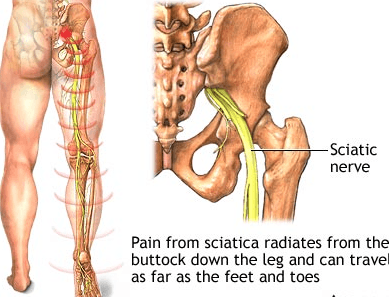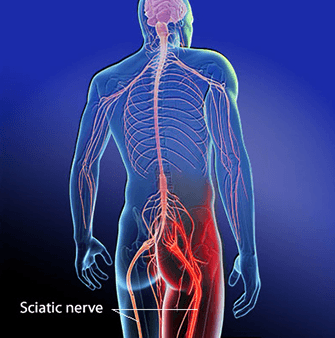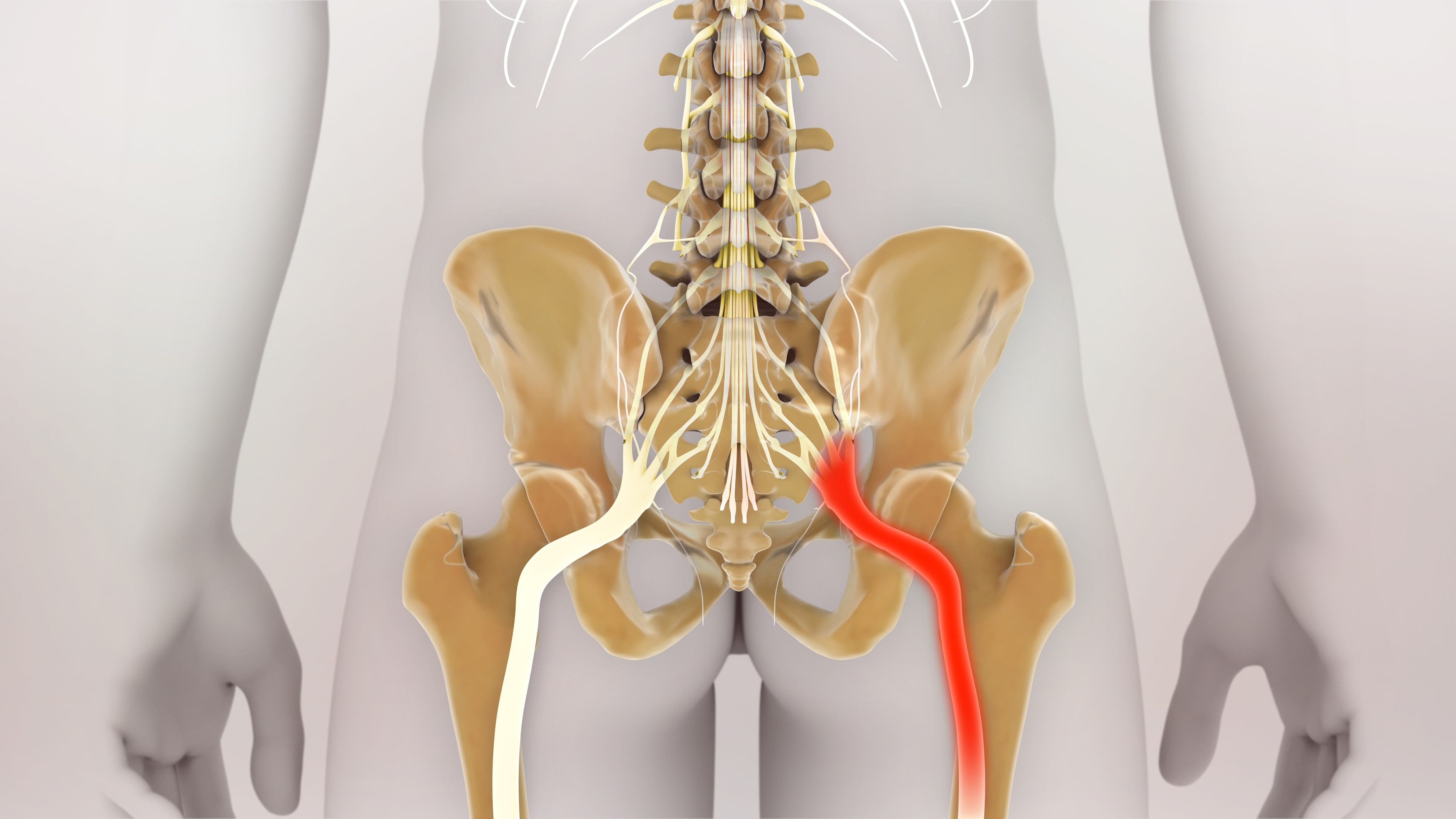The electrifying truths about sciatica.
Jun 9, 2015
It’s electrifying, it’s like lightening, it’s not Lightning McQueen though…It’s sciatica. Electric bolts of pain that is really no fun at all.

Sciatica is not a diagnosis but a description of symptoms. It is the umbrella term that describes pain, tingling, numbness or weakness felt in the leg with the cause of these symptoms originating in the lower back.
Different issues in the lower back, such as a herniated disc (aka slipped disc) or degenerative disc disease (ie general wear and tear of the discs), can cause sciatica.
An estimated 70-90% of people (pretty much all of us!!) will suffer from lower back pain at some point in our lives, according to the Australian governments’ Australian Institute of Health and Welfare. Back pain plagues our society, so let’s get into learning some more about it!
4 wheely fun facts about Sciatic nerve anatomy
The sciatic nerve:
is the largest single nerve in the human body
is as thick as a garden hose in the buttock area
runs from each side of the lower spine, through the buttock and down the back of the leg all the way down to the foot. It therefore connects the spinal cord with the leg and foot muscles.
can be kinked, compressed or irritated at any point along it’s path. This explains why people describe sciatica differently, as it depends on where the pressure on the sciatic nerve occurs.
The sciatic nerve is pictured below:

What’s that about the bolts of lightening again?
Specific sciatica symptoms can be different in location and severity, depending upon the condition causing the sciatica. Typically what patients feel is:
A sharp, shooting pain that may make it difficult to stand up or to walk
Constant pain in only one side of the buttock or leg (it very rarely occurs in both legs)
Pain that is worse when sitting
Leg pain that is often described as burning, tingling or searing (versus a dull ache)
Weakness, numbness or difficulty moving the leg or foot
Sciatic pain can vary from infrequent and irritating to constant and incapacitating.

Getting to the mechanic – how to treat sciatica
For most people suffering from sciatica, conservative treatment and regular exercise will go a long way to relieving pain and any neurological symptoms.
For a specific group of sciatica sufferers, surgery may be required to provide pain relief and minimize neurological damage. (If you have the following symptoms – numbness in the groin or pelvic floor area, loss of bladder/bowell function, sudden loss of motor function in both legs, then you need to present to your nearest Emergency Department as this is not sciatica).
As most cases don’t need to go down the surgical path though, lets look into the broad range of conservative options available for sciatica treatment, with some of the most common and effective options discussed below.
1. Turn the ignition off
In the first couple of days of having acute and severe sciatic symptoms, treatment is focussed on calming the sciatic nerve irritation down. You can:
Take medication – talk to your GP or Sports Physician for the most appropriate medication to take.
Rest – don’t go to work, forget cleaning the house, just concentrate on looking after yourself. Rest in bed just while the pain is disabling and severe. This should go on for no more than 2 days, until the medication kicks in and your symptoms ease. Then, as you’ll see below you must get up and about.
Heat packs – can be a great natural way to give relief and relax the muscles.
When the pain is crippling, it can be more effort than it is worth to get into physio, so just stay at home in this really acute period.
2. Ok, time to slowly turn the ignition on now
After the pain relief has kicked in (after 2-3 days), the focus on treatment will change to help get you up and about slowly. Treatment aspects include:
Relative rest – the term relative rest is hugely different to just resting! This means you can start to get up and about a little bit, but just be guided by pain. It is hugely important to try and prevent too much deconditioning by completely resting.
Heat packs – continue as needed.
Medication – continue, as prescribed by your doctor. For worsening cases, imaging and the possibility of injections may be considered.
Physio – now we can start! After making a diagnosis, your physiotherapist will most likely do some hands on treatment. You will always be sent home with exercises.. just make sure you do them!
Your physio will work with you to:
Reduce the sciatic pain in the short term and help to give you relief
Guide you on conditioning exercises (cardio, strengthening and flexibility exercises appropriate to you) to help prevent future episodes.. Let’s explore the exercises in more detail below!
3. Rev up the engine
When the acute pain subsides, now you must start to gradually and progressively build in some exercises.
(NB these exercises are a guide only. You must consult with a physiotherapist to ensure the exercises are appropriate to your body type and your injury at the time).
A. Stretches
Stretching can help to get things moving again, and may provide relief to spasmed and tight muscle groups. 2 helpful stretches to providing relief from sciatic pain are shown below.


B. Strengthening
What lots of people find quite interesting is that after a bout of back pain, your core muscles turn off. Like a switch. Off. The core completely shuts down.
That is why you need to go back to some basic inner core exercises to reassure to the brain, that it is ok to send a message to the right muscle groups to switch on again. Spend 10 minutes, 2-3 times per day for 2 weeks just activating the deep core and focusing on your breathing. Then you can gradually start to increase the difficulty of the inner core activation exercises.
Have you heard of the 10 000 hour rule? In his book, “Outliers: The Story of Success”, Malcolm Gladwell discusses the need to practice a task for 10 000 hours to train your brain. So, get those inner core activation exercises going!!
Just as you start to wake up your deep core, you will also need to start some buttock muscle activation exercises as well. Similar to the deep core, the buttock muscles also switch off when you have back pain.
How to feel as smooth as a Porsche (injury prevention)
To prevent and manage sciatica and other forms of back pain, our physiotherapists at Physiotonic will help you keep:
strong in the right places – that is from the inside out in areas such as your core, pelvic floor and buttock muscles. The correct tone and strength of these muscle groups are imperative to support the spine and provide stability.
flexible in areas you are tight
good posture
Our classes at Physiotonic, will help you to continually work on these factors to keep your spine healthy and prevent Sciatica…. and of course feel as good as a Porsche!

Check out more:


